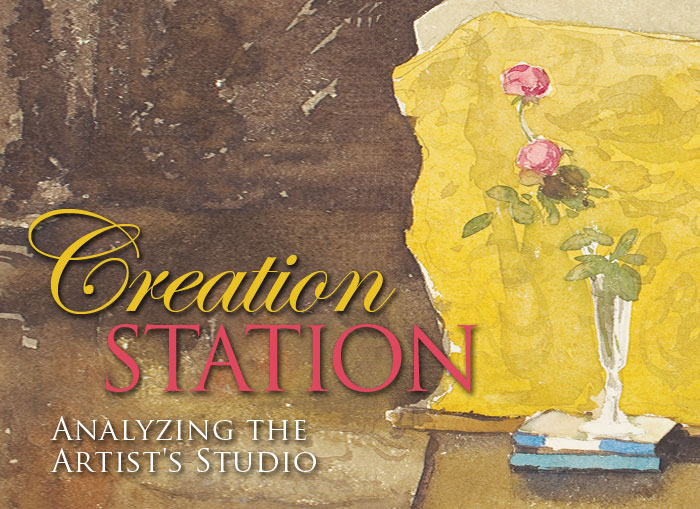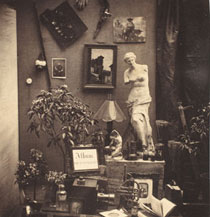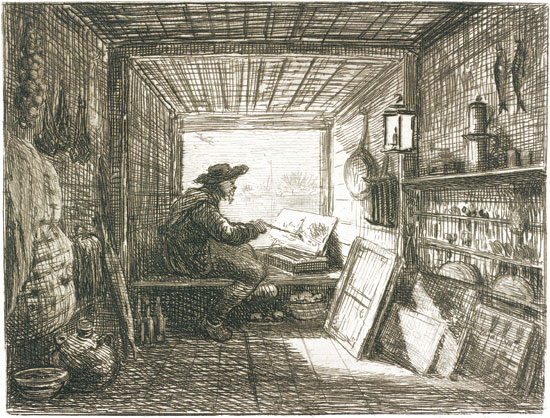By Jo Lynn Orr
|
Studios, like offices and medicine cabinets, can speak volumes. Whether the area in question is a traditional office, the cab of a big rig, the beaker-strewn corner of a lab bench, or the most woeful sliver of cubicle, most of us strive to find some way to put a personal stamp on our place of employment. 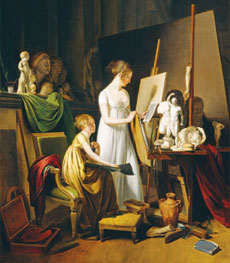 “A Painter’s Studio” (1800) by Louis-Léopold Boilly “A Painter’s Studio” (1800) by Louis-Léopold Boilly
Artists, for whom self-expression is often a primary aim, are especially concerned with cultivating a highly personalized work environment, where they can feel comfortable to create without distraction and to receive guests and clients alike. And for hundreds of years, the general public has been captivated by the idea of taking a peek behind the scenes at artists’ studios, says UAB art historian Heather McPherson, Ph.D. Many artists from the Renaissance onward have gratified this desire by capturing their workspaces on canvas. But the studio as subject was especially popular in 19th-century France, where the Realist movement was born and photography was beginning to offer a new way to document the world. McPherson, an expert on 19th-century French painting, is writing a book about artists and their studios during this period. She notes that representations of studios offer clues to an artist’s creative process and lifestyle—but they also are useful barometers of cultural change. Different Strokes“My research indicates that artists in this period painted their studios for a variety of reasons,” McPherson says. “These works are a form of self-portraiture that is intimately associated with artistic identity. Paintings and photos of artists’ studios also sometimes served as a form of publicity, especially when exhibited publicly or disseminated in the press. And the studio was an integral part of the artist’s everyday existence that he or she might wish to record as a personal document.” Last fall, McPherson had the opportunity to advance her research when she was appointed a Paul Mellon Visiting Senior Fellow at the Center for Advanced Study in the Visual Arts in the National Gallery of Art in Washington, D.C. The two-month fellowship gave McPherson unlimited access to paintings, drawings, prints, and photographs from the National Gallery’s vast collection—and an enviable workspace of her own. 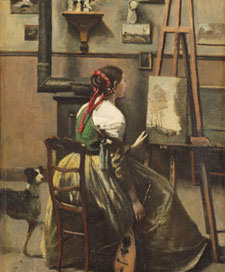 “The Artist’s Studio” (1868) by Jean-Baptiste-Camille Corot “The Artist’s Studio” (1868) by Jean-Baptiste-Camille Corot
“It was spectacular,” McPherson says. “I had a wonderful office on the fourth floor looking out over the Capitol building. There’s a conservation lab at the National Gallery, so I was able to meet with a conservator who specializes in 19th-century French painting. I also viewed X-rays and discussed some of the questions surrounding the techniques that artists used in the paintings.” Evolving ImagesThe rise of photography in mid-19th century France, perhaps surprisingly, was a boon to many painters. “Because photographic images can be more easily reproduced, publications dedicated to artists began to appear in this period,” McPherson says. “These publications often included a portrait or self-portrait of the featured artist, views of his studio, and descriptions of everything from sketches and completed paintings hung on the walls to works in progress on easels.” Photographers also sometimes depicted their studios, as in Alphonse Le Blondel’s “Décor d’atelier, nature morte” (shown below). “Visiting the artist’s studio” became a popular theme in illustrated journals and contributed to the democratization of art, McPherson says. “Before this time, unless you were a member of the art world or knew the artist, you probably wouldn’t have had access.” The paintings, descriptions, and photographs McPherson has found in her research reveal different approaches to the studio, she notes. “Jean-Baptiste-Camille Corot, a French landscape painter and printmaker, was one of the artists whose studio was often visited by fellow artists and journalists.” He depicted his studio in six paintings, one of which is at the National Gallery of Art.
As the 19th century advanced, artists were increasingly leaving their studios in search of new vistas, McPherson says—especially members of the Impressionist movement who turned to painting en plein air (“in the open air”) in this time period. “Artists in the second half of the century were increasingly working out of doors,” McPherson says. But that doesn’t mean that studios were abandoned; instead, she notes, they began to take on a new identity of their own, as in Daubigny’s “Boat Studio.” “I’m very interested in this transitional period,” she says. “There’s this sense of the studio becoming less important” as a solitary creative space. Throughout the second half of the 19th century, the studio remained a central theme in art and literature and a platform for self-expression and the forging of artist identity, McPherson says. “It becomes much less formal and much more of a social space rather than a place where you actually see the artist at work.”
|
